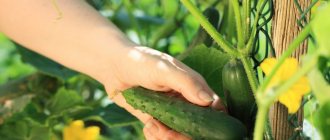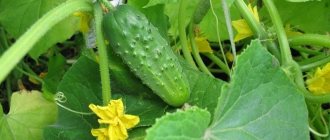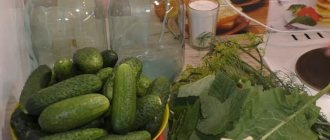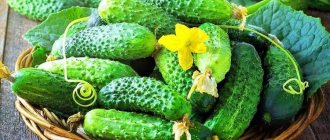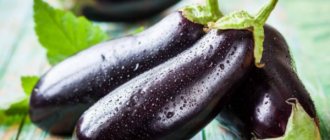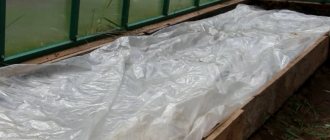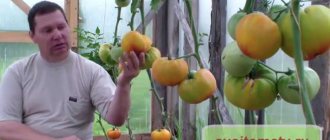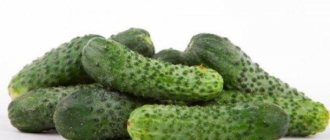How to choose a cucumber variety for growing in a greenhouse in the Urals
Proper selection of planting material largely determines the success of growing vegetables. When purchasing seeds of your choice, you should take into account the climatic characteristics of the region. And the weather in the Urals is varied. Temperature, humidity and the amount of ultraviolet radiation received by plants are not the same in different parts of the region. Basically, a temperate continental climate prevails here, but in the southern part it is sharply continental. If in the south of the Urals the average daily temperature in summer varies between +16...+22 degrees, then in the north it rarely exceeds +9...+10 degrees. For the Trans-Urals, drought is not uncommon, and to the west of the mountains the weather is wet and mild. Most sunny days are observed in the southern Urals, and in the northern Urals the summer is short.
Considering the characteristics of the region and the fact that vegetables will be grown indoors, it is recommended to pay attention to the following aspects when choosing planting material:
- Endurance and unpretentiousness to the environment help plants in greenhouses and greenhouses to withstand weather changes without problems.
- Since the summer period does not last so long, for planting it is better to choose varieties with early and mid-term fruiting (no more than 45...50 days from the time the first foliage appears). Otherwise, the crop may not have time to ripen.
- In closed ground, where neither insects nor wind help in pollinating the crop, the gardener will have less trouble with self-pollinating and parthenocarpic varieties of cucumbers, which do not require outside help to form ovaries.
- Cucumbers growing in protected soil often get sick. It is recommended to choose varieties that are resistant to fungal, infectious and viral diseases.
- In greenhouse conditions, you need to plant cucumbers that, when developing, do not form spreading bushes. Otherwise, the plants will not have enough sunlight, and the gardeners themselves will have difficulty caring for the plantings.
- Despite the harsh climate, decent harvests of vegetables can be harvested in the Urals. Today, varieties have been bred that produce 15…20 kg or more per 1 sq.m. per season.
- It is also important to pay attention to the duration of fruiting of the crop. It is optimal if this period is at least 4 months.
It is recommended to plant several different types of cucumbers in the greenhouse - 3...5 varieties or hybrids. This will guarantee a significant harvest over a long period.
Hybrid crops are best suited for growing in the region, as they are less sensitive to weather conditions. By planting them in a greenhouse, you can expect to receive a harvest until October.
For planting in closed beds, it is recommended to pre-prepare seedlings. Seeds should be sown around mid-April, and seedlings should be transferred to shelter in mid-May (the soil at this time should warm up to at least +15 degrees). These are approximate deadlines when it comes to constructing beds in protected structures.
Reviews from experienced gardeners
Ural gardeners advise not to stop at just one hybrid of cucumbers, but to plant at least 4-5.
Oleg, Yekaterinburg : “I started working with cucumbers when I installed a good greenhouse. Unfortunately, in the conditions of the Urals, not all crops are available for cultivation. I plant hybrids Marinda F1 and Magnificent Five F1. Problems, of course, arise, but they are minor. Thanks to greenhouse conditions, cucumbers have time to ripen. Fruiting lasts for a long time, the taste is excellent.”
Lilia, Chelyabinsk : “In the conditions of the Urals it is difficult to grow cucumbers, but if you follow certain rules, the plants will grow well and bear fruit. For planting I always take hybrids Ant F1 and April F1. I grow it through seedlings. I harvest the crop in several stages. With normal care, the harvest is even enough for sale.”
Self-pollinating varieties for the Urals
Crops that do not require pollination by insects are a godsend for those who have installed a greenhouse. Many varieties and hybrids of this type, differing in the characteristics of the growing season and the type of greens, have been bred.
Ecole
Fruits from these plants can begin to be harvested 42...45 days after the sprouts appear. The hybrid is characterized by high yield (up to 20 kg of gherkins measuring about 110 mm and weighing up to 90 g per 1 sq.m), long-term fruiting (at least 4 months), endurance (tolerates cold and heat), immunity to common diseases, excellent taste characteristics of greens and the versatility of their use. The crop is intended, among other things, for cultivation in the northern regions of our country, in the Urals, in the western and eastern regions of Siberia. Cucumber ovaries are formed in bunches (up to 5 pieces in one bosom). Despite their tall growth, the bushes are not excessively spreading, which makes it easier for the gardener to form them.
April
This variety can be cultivated not only in greenhouses, but also in open ground and on the balcony. April is a high-yielding variety. The first cucumbers ripen a month and a half after the seeds germinate. They grow up to 250 cm in length and gain weight up to 250 g. Cucumbers are tasty, they can be used fresh, but they do not lose their quality when prepared.
The self-pollinating crop begins to bloom even more abundantly and form embryos with the participation of bees in the transfer of pollen. Ripe fruits should not outgrow, otherwise they will begin to become coarse and bitter. The bushes grow tall and medium branched. The process of their formation consists of blinding at the initial stage of the growing season. The culture is characterized by resistance to viruses and root rot.
Zozulya
The hybrid begins to bear fruit 45...48 days after the leaves appear. Gardeners have the right to count on stable harvests, since the plants tolerate various weather disasters well, they are not afraid of excessive shading and practically do not get sick. They can be planted in any type of beds. In the Ural greenhouses it is possible to pick ripe fruits until October.
Zozuli bushes are squat (they rarely grow above 1.5 m). They must be tied up, and cucumbers do not need to be pinched (the number of lateral shoots is optimal for obtaining a decent harvest). The fruits grow up to 250 mm in length, they are juicy, crispy and aromatic.
Early ripening varieties and hybrids suitable for the region
Early and even ultra-early varieties are popular among Ural gardeners.
The Fab Five
The parthenocarpic hybrid is liked by owners of personal plots for its precocity (harvesting can begin 38...40 days after germination), yield (15...16 kg/sq.m), quality characteristics of gherkins (they rarely grow longer than 100 mm), versatility of their use and resistance to diseases.
The crop is not too capricious to growing conditions, but does not tolerate drought well, so it is important to monitor watering. The Magnificent Five bushes grow up to 1.5 m in height, they are quite compact and do not have excess green mass, leading to thickening of plantings. The hybrid can be grown in outdoor garden beds and in protected ground, but when using a greenhouse made of polycarbonate or glass, you don’t have to worry about the harvest, especially in the Urals and Siberia.
Emerald Family
The fruits of this hybrid begin to ripen 40...45 days after the formation of the first leaves. The crop bears fruit consistently, but not for very long. Despite the fact that plants can withstand bad weather, constant exposure to ultraviolet radiation ensures better yield (on average about 15...16 kg).
On tall and slightly spreading bushes, bunches of ovaries are formed (up to 5 pieces in each node). The length of the fruit does not exceed 120 mm. The pulp is juicy, lacks bitterness and has a small number of seeds. Cucumbers can be used for any purpose. The hybrid is not afraid of powdery mildew and spotting. But you need to know that plants are demanding when it comes to nutrition. They should be fed regularly.
Claudine
The crop was developed in Holland and recommended for cultivation in different, even harsh, regions of our country. It takes a little over a month before the first greens begin to ripen on the bushes. Parthenocarpic can be grown in any type of soil, including greenhouse soil. Bushes are determinant, that is, their growth is limited. The green mass is actively developing, so the leaves have to be periodically removed to allow access to sunlight. The ovaries are formed in bouquets (5...7 pieces in each axil).
The fruits grow of medium size (up to 120 mm in length), they are sweet and have no voids. After heat treatment, the structure of the pulp does not change. During a season, you can collect up to 10 kg of cucumbers, which are stored for a long time and can be transported without problems. The culture is immune to mosaic virus and powdery mildew.
Hermann
Also, the parthenocarpic hybrid bred by Dutch breeders is distinguished by: early fruit ripening, long fruiting period, determinacy, decent yield, resistance to most diseases and insect pests. The fruits grow up to 110...120 mm, their weight most often does not exceed 90 g. Cucumbers are for salad purposes, but many housewives canned them. Among Herman's disadvantages: low resistance to cold and heat, capriciousness regarding the nutritional value of the soil.
Amur
Owners of homestead farms like the Russian development due to its high yield (with proper care, you can harvest up to 28 kg of greens per season), early ripening (35 days from the moment sprouts appear), versatility of fruit use, and their taste characteristics. Cucumbers do not grow longer than 140 mm and are not genetically bitter. Plants are not afraid of frost and disease.
Planting seeds in open ground
A suitable area with fertile soil is leveled, loosened, and plant debris and weeds are removed. The holes for planting seeds are made at a distance of 20 cm from each other, 40 cm are left between the rows. The holes are well shed with warm water, 2-3 seeds are placed and covered with soil. Next, the bed is watered and covered with agrospan, so the moisture will evaporate less intensely. Shoots will appear in about 5-7 days, depending on the varietal characteristics, after which the beds are already opened.
Mid-season varieties of cucumbers
Varieties belonging to this category usually have a long fruiting period. Therefore, the number of such crops in a garden bed is usually at least 50%
The following varieties of cucumbers are suitable for the Urals when grown in a greenhouse:
Dynamite
A hybrid that appeared not long ago quickly gained popularity among gardeners. It is productive, resistant to viruses and fungi, immune to ultraviolet deficiency, and cucumbers have excellent quality characteristics. The fruits begin to ripen one and a half months after germination. Their length: about 130 mm, weight: 120...130 g. The bushes do not need pollinators. They grow up to 2.1...2.5 m in height. One embryo is formed in each sinus. Cucumbers are suitable for fresh consumption and for heat treatment.
Karelian
With proper care, the first harvest from this parthenocarpic hybrid can be harvested 42...46 days after germination of the plants. Karelian is not picky about temperature conditions, which makes it possible to cultivate it in regions with harsh climatic conditions. It is also resistant to diseases. The fruits of the crop grow up to 100 mm in length. Their purpose is universal. The yield is 15…16 kg.
Connie
These cucumbers are loved by those who love preparations. Calibrated gherkins, about 80 mm long, are very tasty and aromatic. Their flesh is dense. Voids do not appear even after heat treatment. During the season you can collect up to 16 kg of crispy greens. The fruiting period is 3.5...4 months. Connie's bushes grow tall, but medium spreading. The ovaries are planted in bouquets (up to 9 pieces in a node); there are no empty flowers.
Baby mini
The fruiting period begins 50 days after the formation of the first leaves on the sprouts. A high-yielding (up to 16 kg) hybrid does not require pollination. It belongs to the determinant type; the bushes do not grow above 1 m in height. Despite the strong branching of the plants, they do not need to be formed and tied up due to their miniature size. The length of the gherkins: about 100 mm, their weight: 120...150 g. Crispy cucumbers can be used for various purposes.
Greenhouse
"RMT F1"
The variety is also suitable for open ground, but it is preferable to grow it in greenhouses. Beam early ripening. Forms up to ten ovaries in each node.
The number of simultaneously ripening cucumbers is from twenty to thirty. The variety is universal. Gherkins are up to thirteen centimeters in size. It withstands drought well, producing large yields even in dry summers.
Late-harvesting cucumbers recommended for the Urals
Despite the fact that such crops cannot be harvested for a long time, the quality characteristics of the fruit are appreciated by all gardeners.
Marinda
Distinctive features of parthenocarpic: excellent yield (up to 27 kg/sq.m) when grown in protected soil, unpretentiousness to climatic disasters, disease resistance, versatility of fruit use. The bushes grow compact, so gardeners can easily care for them.
Cucumbers begin to ripen on the 50th day. The female hybrid has a bunched type of flowering. Gherkins are distinguished by their small size (up to 100 mm in length), lack of bitterness in both the pulp and skin, sweet taste and delicate aroma. They are stored for a long time and used for any purpose.
Erofey
These plants require pollination to produce fruit. Therefore, when growing in greenhouses, where insects rarely fly, you have to perform this procedure yourself. However, the culture's resistance to cold and lack of light, as well as high immunity to disease, are advantages for many. The fruits can be harvested 50 days after the sprouts hatch. On developed, spreading bushes, gherkins grow no more than 70 mm long. They can be eaten fresh and used in canning.
Hercules
The hybrid type crop is perfectly suited for growing in different regions. But pollination also requires the help of bees or the gardener himself. Dates for the start of ripening of greens: 55...65 days. They grow up to 200mm in length and are mainly used for making salads. In greenhouses it is possible to get up to 40 kg from 1 sq.m of bed. Hercules is characterized by endurance and resistance to diseases; the name of the cucumber speaks for itself.
